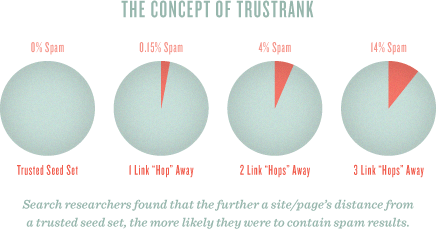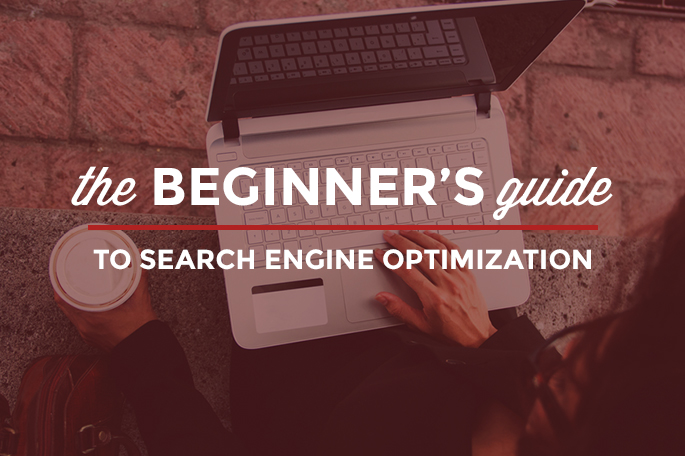For search engines that crawl the vast metropolis of the web, links are the streets between pages. Using sophisticated link analysis, the engines can discover how pages are related to each other and in what ways.
Since the late 1990s search engines have treated links as votes for popularity and importance in the ongoing democratic opinion poll of the web. The engines themselves have refined the use of link data to a fine art, and use complex algorithms to perform nuanced evaluations of sites and pages based on this information.
Links aren’t everything in SEO, but search professionals attribute a large portion of the engines’ algorithms to link-related factors (see Search Engine Ranking Factors). Through links, engines can not only analyze the popularity websites and pages based on the number and popularity of pages linking to them, but also metrics like trust, spam, and authority. Trustworthy sites tend to link to other trusted sites, while spammy sites receive very few links from trusted sources (see MozTrust). Authority models, like those postulated in the Hilltop Algorithm, suggest that links are a very good way of identifying expert documents on a given subject.

Link Signals
Used by search engines
How do search engines assign value to links? To answer this, we need to explore the individual elements of a link, and look at how the search engines assess these elements. We don’t fully understand the proprietary metrics that search engines use, but through analysis of patent applications, years of experience, and hands-on testing, we can draw some intelligent assumptions that hold up in the real world. Below is a list of notable factors worthy of consideration. These signals, and many more, are considered by professional SEOs when measuring link value and a site’s link profile. You may also enjoy some further on the Moz Blog reading about search engine valuation of links.
Global Popularity
The more popular and important a site is, the more links from that site matter. A site like Wikipedia has thousands of diverse sites linking to it, which means it’s probably a popular and important site. To earn trust and authority with the engines, you’ll need the help of other link partners. The more popular, the better.
Local/Topic-Specific Popularity
The concept of “local” popularity, first pioneered by the Teoma search engine, suggests that links from sites within a topic-specific community matter more than links from general or off-topic sites. For example, if your website sells dog houses, a link from the Society of Dog Breeders matters much more than one from a site about roller skating.
Anchor Text
One of the strongest signals the engines use in rankings is anchor text. If dozens of links point to a page with the right keywords, that page has a very good probability of ranking well for the targeted phrase in that anchor text. You can see examples of this in action with searches like “click here,” where many results rank solely due to the anchor text of inbound links.
TrustRank
It’s no surprise that the Internet contains massive amounts of spam. Some estimate as much as 60% of the web’s pages are spam. In order to weed out this irrelevant content, search engines use systems for measuring trust, many of which are based on the link graph. Earning links from highly-trusted domains can result in a significant boost to this scoring metric. Universities, government websites and non-profit organizations represent examples of high-trust domains.
Link Neighborhood
Spam links often go both ways. A website that links to spam is likely spam itself, and in turn often has many spam sites linking back to it. By looking at these links in the aggregate, search engines can understand the “link neighborhood” in which your website exists. Thus, it’s wise to choose those sites you link to carefully and be equally selective with the sites you attempt to earn links from.
Freshness
Link signals tend to decay over time. Sites that were once popular often go stale, and eventually fail to earn new links. Thus, it’s important to continue earning additional links over time. Commonly referred to as “FreshRank,” search engines use the freshness signals of links to judge current popularity and relevance.
Social Sharing
The last few years have seen an explosion in the amount of content shared through social services such as Facebook, Twitter, and Google+. Although search engines treat socially shared links differently than other types of links, they notice them nonetheless. There is much debate among search professionals as to how exactly search engines factor social link signals into their algorithms, but there is no denying the rising importance of social channels.

The Power of Social Sharing
How Google+, Twitter, and Facebook Change the Game
The years 2011-2012 saw a huge rise in social sharing and its effects on search. Google, in particular, began to incorporate a huge number of social signals into its search results. This involves serving personalized results to logged-in users that include content shared by the searcher’s social circle (Facebook, Twitter and others). These results might not always appear in the top ten, but are undoubtedly promoted due to this social influence.
The potential power of this shift towards social for search marketers is huge. Someone with a large social circle, who shares a lot of material, is more likely to see that material (and her face) promoted in search results. For publishers, it’s beneficial to have your content shared by these highly influential folks with large social followings. For Google searches, this is especially true of content shared on Google+.
Are Social Shares the Same as Links?
In a word: no. Although there is evidence that social shares such as Tweets, Likes, and Plusses affect rankings, at this time links are considered a far superior and more lasting way to promote the popularity of your content than any other method.
Link Building Basics
Link building is an art. It’s almost always the most challenging part of an SEO’s job, but also the one most critical to success. Link building requires creativity, hustle, and often, a budget. No two link building campaigns are the same, and the way you choose to build links depends as much upon your website as it does your personality. Below are three basic types of link acquisition.
- “Natural” Editorial LinksLinks that are given naturally by sites and pages that want to link to your content or company. These links require no specific action from the SEO, other than the creation of worthy material (great content) and the ability to create awareness about it.
- Manual “Outreach” Link BuildingThe SEO creates these links by emailing bloggers for links, submitting sites to directories, or paying for listings of any kind. The SEO often creates a value proposition by explaining to the link target why creating the link is in their best interest. Examples include filling out forms for submissions to a website award program or convincing a professor that your resource is worthy of inclusion on the public syllabus.
- Self-Created, Non-EditorialHundreds of thousands of websites offer any visitor the opportunity to create links through guest book signings, forum signatures, blog comments, or user profiles. These links offer the lowest value, but can, in the aggregate, still have an impact for some sites. In general, search engines continue to devalue most of these types of links, and have been known to penalize sites that pursue these links aggressively. Today, these types of links are often considered spammy and should be pursued with caution.
It’s up to you, as an SEO, to select which of these will have the highest return on the effort invested. As a general rule, it’s wise to build as vast and varied a link profile as possible, as this brings the best search engine results. Any link building pattern that appears non-standard, unnatural, or manipulative will eventually become a target for advancing search algorithms to discount.
As with any marketing activity, the first step in any link building campaign is the creation of goals and strategies. Unfortunately, link building is one of the most difficult activities to measure. Although the engines internally weigh each link with precise, mathematical metrics, it’s impossible for those on the outside to access this information.
SEOs rely on a number of signals to help build a rating scale of link value. Along with the data from the link signals mentioned above, these metrics include the following:
Ranking for Relevant Search Terms
One of the best ways to determine how highly a search engine values a given page is to search for some of the keywords and phrases that page targets (particularly those in the title tag and headline). For example, if you are trying to rank for the phrase “dog kennel,” earning links from pages that already rank for this phrase would help significantly.
MozRank
MozRank (mR) shows how popular a given web page is on the web. Pages with high MozRank scores tend to rank better. The more links to a given page, the more popular it becomes. Links from important pages (like www.cnn.com or www.irs.gov) increase a page’s popularity, and subsequently its MozRank, more than unpopular websites.
A page’s MozRank can be improved by getting lots of links from semi-popular pages, or a few links from very popular pages.
Domain Authority
Moz Domain Authority (or DA) is a query-independent measure of how likely a domain is to rank for any given query. DA is calculated by analyzing the Internet’s domain graph and comparing a given domain to tens of thousands of queries in Google.
Competitor’s Backlinks
By examining the backlinks (inbound links) of a website that already ranks well for your targeted keyword phrase, you gain valuable intelligence about the links that help them achieve this ranking. Using tools like Open Site Explorer, SEOs can discover these links and target these domains in their own link building campaigns.
Number of Links on a Page
According to the original PageRank formula, the value that a link passes is diluted by the presence of other links on a page. Thus, all other things being equal, being linked to by a page with few links is better than being linked to by a page with many links. The degree to which this is relevant is unknowable (in our testing, it appears to be important, but not overwhelmingly so), but it’s certainly something to be aware of as you conduct your link acquisition campaign.
Potential Referral Traffic
Link building should never be solely about search engines. Links that send high amounts of direct click-through traffic not only tend to provide better search engine value for rankings, but also send targeted, valuable visitors to your site (the basic goal of all Internet marketing). This is something you can estimate based on the numbers of visits or page views according to site analytics. If you can’t get access to these, services like Google Trends can give you a rough idea of at least domain-wide traffic, although these estimates are known to be wildly inaccurate at times.
It takes time, practice, and experience to build comfort with these variables as they relate to search engine traffic. However, using your websites analytics, you should be able to determine whether your campaign is successful.
Success comes when you see increases in search traffic, higher rankings, more frequent search engine crawling and increases in referring link traffic. If these metrics do not rise after a successful link building campaign, it’s possible you either need to seek better quality link targets, or improve your on-page optimization.
Five Samples of Link Building Strategies
Get your customers to link to you
-
- If you have partners you work with regularly, or loyal customers that love your brand, you can capitalize on this by sending out partnership badges—graphic icons that link back to your site (like Google often does with their AdWords certification program). Just as you’d get customers wearing your t-shirts or sporting your bumper stickers, links are the best way to accomplish the same feat on the web. Check out this post on e-commerce links for more.
Build a company blog; make it a valuable, informative, and entertaining resource
- This content and link building strategy is so popular and valuable that it’s one of the few recommended personally by the engineers at Google (for more on this, see articles at USA Today and Stone Temple). Blogs have the unique ability to contribute fresh material on a consistent basis, participate in conversations across the web, and earn listings and links from other blogs, including blogrolls and blog directories.
Create content that inspires viral sharing and natural linking
- In the SEO world, we often call this “linkbait.” Good examples might include David Mihm’s Local Search Ranking Factors, Compare the Meerkat, or the funny How Not To Clean a Window. Each leverages aspects of usefulness, information dissemination, or humor to create a viral effect. Users who see it once want to share it with friends, and bloggers/tech-savvy webmasters who see it will often do so through links. Such high quality, editorially earned votes are invaluable to building trust, authority, and rankings potential.
Be newsworthy
- Earning the attention of the press, bloggers and news media is an effective, time-honored way to earn links. Sometimes this is as simple as giving away something for free, releasing a great new product, or stating something controversial.
The link building activities you engage in depend largely on the type of site you’re working with.
For smaller sites, manual link building, including directories, link requests, and link exchanges may be a part of the equation. With larger sites, these tactics tend to fall flat and more scalable solutions are required. Sample strategies are listed here, though this is by no means an exhaustive list (see Moz’s Blog Posts on Link Building for more).
Search for sites like yours by using keywords and phrases directly relevant to your business. When you locate sites that aren’t directly competitive, email them, use their online forms, call them on the phone, or even send them a letter by mail to start a conversation about getting a link. Check out this blog post on link requests for more detail.
Show Me the Money
An aside on buying links
Google and Bing seek to discount the influence of paid links in their organic search results. While it is impossible for them to detect and discredit all paid links, the search engines put a lot of time and resources into finding ways to detect these. Websites caught buying links or participating in link schemes risk severe penalties that will drop their rankings into oblivion. Notwithstanding these efforts, link buying sometimes works; many search professionals wish the search engines would do even more to discourage it.
We recommend spending your time on long-term link building strategies that focus on building links naturally.
- How Search Engines Operate
- How People Interact With Search Engines
- Why Search Engine Marketing is Necessary
- The Basics of Search Engine Friendly Design & Development
- Keyword Research
- How Usability, Experience, & Content Affect Rankings
- Growing Popularity and Links
- Search Engine’s Tools for Webmasters Intro
- Myths & Misconceptions About Search Engines
- Measuring and Tracking Success
To access the INTRO page, click here.
If you want to Master SEO, check this:

Written by Rand Fishkin and Moz Staff
